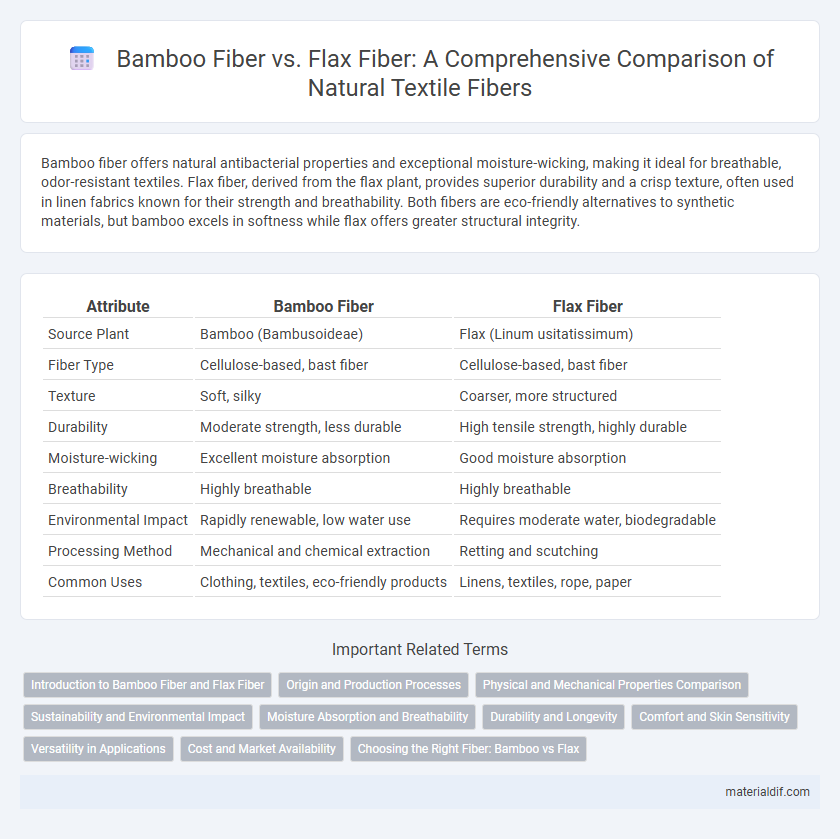Bamboo fiber offers natural antibacterial properties and exceptional moisture-wicking, making it ideal for breathable, odor-resistant textiles. Flax fiber, derived from the flax plant, provides superior durability and a crisp texture, often used in linen fabrics known for their strength and breathability. Both fibers are eco-friendly alternatives to synthetic materials, but bamboo excels in softness while flax offers greater structural integrity.
Table of Comparison
| Attribute | Bamboo Fiber | Flax Fiber |
|---|---|---|
| Source Plant | Bamboo (Bambusoideae) | Flax (Linum usitatissimum) |
| Fiber Type | Cellulose-based, bast fiber | Cellulose-based, bast fiber |
| Texture | Soft, silky | Coarser, more structured |
| Durability | Moderate strength, less durable | High tensile strength, highly durable |
| Moisture-wicking | Excellent moisture absorption | Good moisture absorption |
| Breathability | Highly breathable | Highly breathable |
| Environmental Impact | Rapidly renewable, low water use | Requires moderate water, biodegradable |
| Processing Method | Mechanical and chemical extraction | Retting and scutching |
| Common Uses | Clothing, textiles, eco-friendly products | Linens, textiles, rope, paper |
Introduction to Bamboo Fiber and Flax Fiber
Bamboo fiber, derived from the pulp of bamboo grass, is renowned for its natural antibacterial properties, high moisture absorption, and eco-friendly cultivation. Flax fiber, extracted from the stalks of the flax plant, is valued for its strength, breathability, and lightweight texture, commonly used in linen textiles. Both fibers offer sustainable alternatives to synthetic materials, with bamboo fiber excelling in softness and antibacterial qualities, while flax fiber is preferred for its durability and traditional textile applications.
Origin and Production Processes
Bamboo fiber originates from the pulp of bamboo grass and undergoes a mechanical or chemical process to extract the cellulose fibers, typically involving steam explosion or enzymatic treatment. Flax fiber is derived from the stalks of the flax plant, where retting, scutching, and hackling processes separate and refine the long bast fibers. Both fibers require specialized extraction methods, but bamboo fiber production emphasizes sustainability through rapid growth of bamboo, while flax fiber production relies on traditional agricultural processing of flax plants.
Physical and Mechanical Properties Comparison
Bamboo fiber exhibits superior tensile strength and better moisture absorption compared to flax fiber, making it more durable and comfortable for textile applications. Flax fiber, however, offers higher stiffness and better thermal conductivity, which enhances its performance in composite materials requiring rigidity and heat dissipation. Both fibers show distinct mechanical and physical properties, with bamboo favoring flexibility and moisture management, while flax excels in structural support and thermal stability.
Sustainability and Environmental Impact
Bamboo fiber is highly sustainable due to its rapid growth rate and minimal need for pesticides or fertilizers, making it an eco-friendly alternative to traditional fibers. Flax fiber, derived from the flax plant, also offers strong environmental benefits through low water usage and biodegradability, with a cultivation process that enriches soil health. Both fibers contribute to reducing carbon footprints, but bamboo's faster renewability and lower resource demands give it a slight edge in sustainability metrics.
Moisture Absorption and Breathability
Bamboo fiber exhibits superior moisture absorption and breathability compared to flax fiber, making it ideal for humidity-prone environments. Bamboo's micro-gaps and bamboo charcoal elements enable efficient wicking of sweat and rapid drying, enhancing comfort during wear. In contrast, flax fiber, while breathable, has a coarser structure that retains more moisture and dries slower, reducing overall ventilation efficiency.
Durability and Longevity
Bamboo fiber exhibits high durability due to its strong cellulose structure and natural antimicrobial properties, making it resistant to wear and tear over time. Flax fiber, known for its exceptional tensile strength and moisture-wicking capabilities, provides excellent longevity when maintained properly, especially in linen textiles. Both fibers offer sustainable options, but bamboo's faster regeneration rate enhances its appeal for long-lasting, eco-friendly fabrics.
Comfort and Skin Sensitivity
Bamboo fiber offers exceptional softness and breathability, making it highly comfortable for sensitive skin due to its hypoallergenic and moisture-wicking properties. Flax fiber, derived from flax plants, provides a naturally coarse texture but improves with washing, offering durability while being gentle on the skin. Both fibers support skin health, but bamboo fiber is often preferred for enhanced softness and irritation reduction.
Versatility in Applications
Bamboo fiber offers exceptional versatility in applications, ranging from textiles and apparel to eco-friendly packaging and home furnishings, due to its softness, antibacterial properties, and moisture-wicking ability. Flax fiber, derived from the flax plant, excels in producing durable linen fabrics, composite materials, and high-performance bioplastics, valued for its strength and biodegradability. Both fibers support sustainable manufacturing, but bamboo fiber's adaptability across diverse industries highlights its broader application spectrum compared to flax fiber.
Cost and Market Availability
Bamboo fiber tends to be more cost-effective due to its rapid growth and sustainable harvesting methods, making it widely available in global markets. Flax fiber, derived from the flax plant, often incurs higher production costs because of its labor-intensive processing and limited cultivation regions. Market availability of flax fiber is more niche and specialized, while bamboo fiber dominates mass-market applications due to scalable supply chains and lower price points.
Choosing the Right Fiber: Bamboo vs Flax
Bamboo fiber offers natural antibacterial properties and exceptional moisture-wicking capabilities, making it ideal for activewear and sensitive skin. Flax fiber, derived from the flax plant, is highly breathable and durable, preferred in linen textiles for its crisp texture and eco-friendly cultivation. Choosing between bamboo and flax fiber depends on the desired fabric properties, such as softness and antimicrobial benefits from bamboo or the strength and breathability of flax.
Bamboo Fiber vs Flax Fiber Infographic

 materialdif.com
materialdif.com